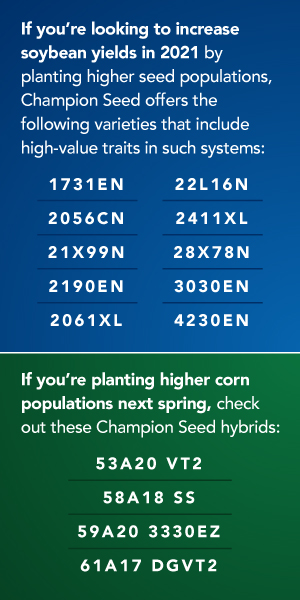Higher corn and soybean plant populations call for these traits to maximize yield potential.
From the combine cab, you have a front-row seat to watch the story of your crop’s growing season. Fluctuating numbers on your yield monitor help tell the story of how well you matched your corn and soybean varieties to their growing conditions. You’re taking mental notes about where you’ve seen yield spike, where it’s dragged and everywhere in-between, all observations that will contribute to your 2021 seed-buying decisions.
In a time when grain markets strain corn and soybean revenue potential, farmers are pushing to maximize yield. One way to do that is by increasing plant populations. The more plants per acre, the more yield per acre, right? Not always…maximizing yield potential in any production system requires close attention to growing conditions, and that’s especially true when planting exceeding numbers, like 30,000 plants/acre for corn and 150,000/acre for soybeans. So what traits should you select that will net you top yields in these higher plant population environments in 2021?
“Alterations in soybean plant spacing through row spacing and plant populations have a significant effect on canopy development and yield components. Higher plant populations result in canopy closure earlier in the season and greater light interception. Decreasing the time to canopy closure can reduce soil moisture loss, increase the ability to control emerging weeds and increase crop growth rate,” according to Iowa State University Extension Cropping Systems Specialist Mark Licht. “However, greater populations do not always result in higher yields. Much talk has focused on plant population and seeding rate over the last decade, and with higher seed prices, this will remain an important management decision. Planting more seeds as insurance seldom pays off in higher yields.”
What’s your environment?
First, consider general traits that will lend themselves to optimal plant development in high plant population environments. For example, soybean plant style and composition are important; narrow or medium-sized plants with strong stems that aren’t as prone to lodging — Like Champion Seed varieties 1731EN and 2061XL — perform better when planted at a higher rate than those with a more bushy, thin-stemmed profile. Champion’s 28X78N variety also offers a strong combination of yield, pest defense and high performance in narrow-row or high-population environments. For corn, stalk strength, ear girth and canopy structure are all important in high-population fields, especially given that stalk diameters typically decrease when plants are more crowded.
Once you’ve identified the traits that check these boxes, the process continues by looking down. Conduct a thorough assessment of your soils, accounting for things like drainage, nutrition and general structure. Crop standability — especially in corn — depends largely on your soil, especially in high-population environments. Well-drained and structured soils with good nutrient balance will be more likely to support a higher seeding rate once those plants reach later vegetative and reproductive growth stages. Champion offers varieties like 53A20 and 61A17 DGVT2 that perform well in high-population fields, especially where standability is a common challenge.
 Consider past challenges.
Consider past challenges.
It’s also important to do your homework and consider past agronomic issues that could become bigger challenges when you sow a higher seed count. With soybeans, for example, a field with a history of white mold, charcoal rot or stem canker — especially if in a high-humidity region — is a likely candidate for varieties with good tolerance to the most common of these diseases. Champion’s 4230EN, 3030EN and 22L16N soybean varieties have high tolerance to these and other common diseases.
Cuts in yield potential in higher-population fields don’t just come from diseases and weeds. When planted more densely, corn plants can sometimes compete with one another for vital resources like sunlight. That makes hybrids with more upright leaf structures and narrower canopies better for high-population fields — they allow more sunlight to penetrate deeper down into lower portions of each plant and maximize photosynthesis for both vegetative and reproductive development. Consider a corn variety like Champion 58A18 SS to optimize photosynthesis in high-population fields.
Do your homework.
Remember, when it comes to seed populations, more isn’t always better. It’s important to consider environmental factors like soil conditions, especially at key times during the growing season, like shortly after planting when the crops are emerging. Harvest is the perfect time to connect conditions like these to yield in determining your best seed options for 2021. While modern seed genetics offer specific traits to maximize yield potential when facing an array of field and growing conditions, it’s best to start the 2021 hybrid purchase decision-making process by consulting your Champion Seed dealer or agronomist. Get in touch and take a few minutes to read up on our corn and soybean hybrids today.

Rob Thomas
Soybean Production
Results may vary. Always read and follow label instructions. Not all products are registered for use in all states.



